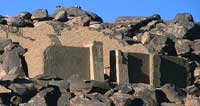|
Beit el Wali
 Beit (Beyt) el-Wali, today, is located just south of the Aswan
High Dam, very close to the Kalabsha Temple. Beit el Wali is one
of the cluster of moments that were moved to New Kalabsha during
the construction of the High Dam in order to avoid their burial
beneath this great lake Beit (Beyt) el-Wali, today, is located just south of the Aswan
High Dam, very close to the Kalabsha Temple. Beit el Wali is one
of the cluster of moments that were moved to New Kalabsha during
the construction of the High Dam in order to avoid their burial
beneath this great lake
Beit el-Wali represents another of Ramesses II's Nubian
monuments dedicated principally to Amun, together with other
gods, that was carved from the sandstone hillside and is
probably unique as the smallest of its gender.
The temple was probably originally fronted by a brick pylon and
was built on a symmetrical cruciform plan, and consisted of a
deep hall, a transverse antechamber with two columns and a
sanctuary. Known as a speos, the temple was mostly hewn from the
surrounding rock, except for the front wall of the deep hall
with its central doorway.
 There are low reliefs of considerable historic value because
they provide depictions of the Syrian, Libyan (right wall), and
Ramesses II's triumph over the Nubians (left wall). The scenes
of the Nubian campaigns also depict several sons of Ramesses II
engaged in battle. There are two proto-Doric columns with
brightly colored scenes inside the temple showing Ramses making
offerings to the gods of Horus, Khnum, Satet and Anukis. There are low reliefs of considerable historic value because
they provide depictions of the Syrian, Libyan (right wall), and
Ramesses II's triumph over the Nubians (left wall). The scenes
of the Nubian campaigns also depict several sons of Ramesses II
engaged in battle. There are two proto-Doric columns with
brightly colored scenes inside the temple showing Ramses making
offerings to the gods of Horus, Khnum, Satet and Anukis.
Archaeologists have suggested that there were as many as four
stages of construction resulting in this small temple. During
the early Coptic era, the temple was transformed into a church. |